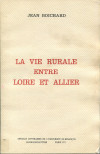
- Résumé
-
This book shows a typical selection of the types of adsorbents studied and used in wastewater treatment, with emphasis on industrial effluents. The types of materials considered range from conventional sorbents such as carbons and silicas, to non-conventional solids such as sawdust and chitosan. Sorbents for specific applications (e.g. colour removal, metal extraction, fluoride removal) and new polymeric-based sorbents (calixarenes, molecularly imprinted polymers, cyclodextrins) are discussed in detail. For people who are new to the field, two special overview chapters, dealing with the principles and properties of adsorption processes, are provided at the beginning of the book. Also, the book provides a detailed review of sorption features.
- Sommaire
-
Preface
List of contributors
Abstracts
Contents
Chapter 1. Sorption processes and pollution: An introduction
Grégorio Crini and Pierre-Marie Badot
Chapter 2. Wastewater treatment by sorption
Grégorio Crini
Chapter 3. Fixed-bed adsorption studies
Adriana S. Franca and Leandro S. Oliveira
Chapter 4. Adsorption of phenolic compounds on activated carbons
Mariusz Barczak and Andrzej Dabrowski
Chapter 5. Influence of thermal and chemical treatments on activated carbon characteristics, and effects on adsorption performance with respect to dyes, emerging contaminants and humic acids
Sarra Gaspard, Marie-Julie Pintor, Axelle Durimel and Valérie Jeanne-Rose
Chapter 6.Silicas adsorbents for pollutants removal
Sławomir Binkowski
Chapter 7. Non-conventional sorbents for dye removal
François Renault, Nadia Morin-Crini, Pierre-Marie Badot and Grégorio Crini
Chapter 8. Kaolin as an adsorbent for color removal
Aparajita Goswami and Mihir Kumar Purkait
Chapter 9. Wood sawdust, tree bark and wood chips: Waste lignocellulosic materials for dye removal
Viorica Dulman and Simona-Maria Cucu-Man
Chapter 10. Polysaccharides for metal ion recovery – A focus on chitosan
Jacques Desbrieres and Eric Guibal
Chapter 11. Non-conventional adsorbents for the removal of metal compounds from wastewaters
Fabio Montagnaro and Luciano Santoro
Chapter 12. Pollutant removal from surface-treatment industry wastewaters by starch-based sorbents: Chemical abatement and impact on water toxicity
Jérémie Charles, Bertrand Sancey, Giuseppe Trunfio, Pierre-Marie Badot, Michel de Carvalho, Albert Colin, Michaël Rietmann, Jean-François Minary, Emmanuel Grosjean and Grégorio Crini
Chapter 13. Defluoridation of water and wastewater using non-conventional sorbents
Giuseppe Trunfio, Bertrand Sancey, Xavier Hutinet and Grégorio Crini
Chapter 14. Fungal biomasses: non conventional biosorbents for organic and inorganic pollutants
Valeria Tigini, Valeria Prigione, Ilaria Donelli, Antonella Anastasi, Francesca Isella, Giuliano Freddi and Giovanna Cristina Varese
Chapter 15. Cross-linked cyclodextrins for pollutant removal
Bertrand Sancey, Grégorio Crini, Giuseppe Trunfio, Nadia Morin-Crini and Giangiacomo Torri
Chapter 16. Calixarene based materials for cations and anions
Mustafa Yilmaz, Abdulkadir Sirit and Hasalettin Deligoz
Chapter 17. Recent advances in porosinit-based nanocomposite adsorbents for pollutants removal from waters
Bingcai Pan, Xiaolin Zhang, Weiming Zhang, Lu Lv and Quanxing Zhang
Chapter 18. Molecularly imprinted polymers (mips) as selective sorbents for wastewater pollutants
George Z. Kyzas and Nikolaos K. Lazaridis
Chapter 19. Nanoparticles for pollutants removal
Yousef Haik and Shahnaz Qadri
Biography and address of contributors
Key-words
Nomenclature
Greek Letters
Notation
- Auteur(s)
-
Grégorio CRINI (dir.)Grégorio Crini, environmental polymerist, received his PhD in organic and macromolecular chemistry from the university of Lille in 1995. He joined the university of Franche-Comté at Besançon in 1997 where he was made research director in 2000. His current interests focus on the design of novel polymer networks and the environmental aspects of polysaccharide chemistry.Pierre-Marie BADOT (dir.)Pierre-Marie Badot, environmental biologist, received his PhD in plant sciences from the university of Franche-Comté in 1987. He became research director in 1991 and full professor in 1993. His main scientific work deals with responses of living organisms to abiotic stress: pollutant transfer and effects of pollution on ecosystems.
- Public
-
The intended audience for this book includes students, environmentalists, engineers, water scientists, civil and industrial personnel who wish to specialize in adsorption technology.
- éléments téléchargeables
- Recensions et revues de presse












